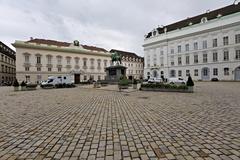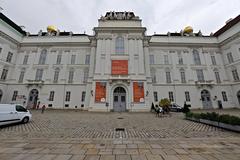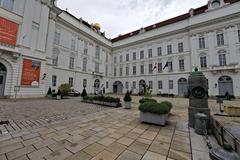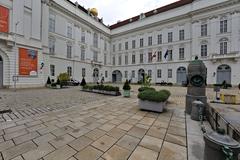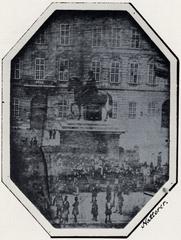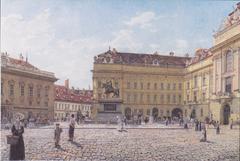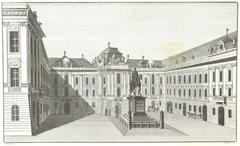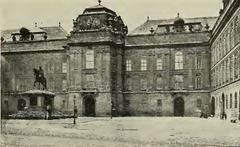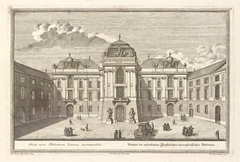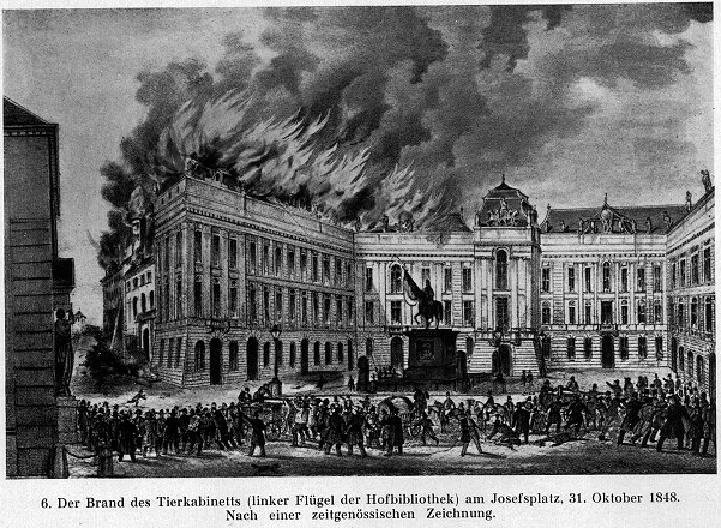
Josefsplatz Vienna: Visiting Hours, Tickets, and Historical Sites Guide
Date: 14/06/2025
Introduction: The Significance and History of Josefsplatz
Located in the historic heart of Vienna’s Innere Stadt, Josefsplatz is a striking emblem of the city’s imperial heritage and architectural splendor. Integral to the Hofburg Palace complex, this elegant square invites visitors to journey through Vienna’s layered history—from its Roman origins as Vindobona to its prominence under the Habsburg monarchy. Named after Emperor Joseph II, a pivotal Enlightenment reformer, Josefsplatz reflects the cultural and political narratives that have shaped Austria’s capital for centuries (World City History; Evendo).
The square is renowned for its harmonious blend of Baroque and Neoclassical architecture, most notably the Austrian National Library’s Prunksaal (State Hall), considered one of the world’s most magnificent Baroque library halls (Vienna Unwrapped; All About Vienna). Flanked by the Augustinian Church—famous for its Gothic architecture and royal weddings—and the refined Palais Pallavicini and Palais Pálffy, Josefsplatz exudes a unique historical and cultural ambiance.
Today, Josefsplatz remains a vibrant cultural hub, hosting events and embodying Vienna’s famous coffee house culture—recognized by UNESCO as intangible cultural heritage. Its location, just steps from major attractions like the Kunsthistorisches Museum, Hofburg Palace, and St. Stephen’s Cathedral, makes it a central highlight of any Vienna itinerary (The Vienna Blog).
This guide provides a detailed overview of Josefsplatz’s historical background, architectural highlights, cultural significance, and essential visitor information, including hours, tickets, accessibility, and travel tips. Whether you are a history enthusiast, architecture lover, or curious traveler, this resource will help you make the most of your visit to one of Vienna’s most cherished sites.
Table of Contents
- Early Origins and Roman Foundations
- Medieval Growth and the Rise of a Capital
- The Habsburg Era and Josefsplatz’s Creation
- Architectural Highlights
- The Austrian National Library: Prunksaal (State Hall)
- Key Monuments and Palaces
- Visiting Hours, Tickets, and Accessibility
- Cultural and Social Significance
- Getting There and Travel Tips
- Nearby Attractions
- Frequently Asked Questions (FAQ)
- Summary and Further Resources
Early Origins and Roman Foundations
The area now known as Josefsplatz lies at the core of Vienna’s Innere Stadt, with roots stretching back to early Celtic settlements and a significant Roman legacy. In the 1st century AD, the Romans established Vindobona, a military camp that laid the groundwork for Vienna’s later development. Archaeological finds beneath the city regularly reveal these origins, demonstrating the deep historical layering of this district (World City History).
Medieval Growth and Vienna’s Emergence
After the fall of the Roman Empire, Vienna evolved through periods of migration and the rise of new kingdoms. By the medieval era, it was a thriving urban hub at the crossroads of European trade, serving as the seat of the Babenberg and later the Habsburg dynasties. The area around present-day Josefsplatz grew in political and economic significance during this time (World City History).
The Habsburg Era and the Creation of Josefsplatz
Josefsplatz took its present form in the early 18th century during the Habsburgs’ grand expansion of the Hofburg Palace complex. Named for Emperor Joseph II, the square was designed to reflect imperial power and the progressive ideals of the Enlightenment. Its centerpiece, the equestrian statue of Joseph II, was erected in 1807, symbolizing the emperor’s reformist legacy (Evendo).
Architectural Highlights of Josefsplatz
Josefsplatz is celebrated for its cohesive Baroque and Neoclassical architecture. The southern edge is dominated by the Prunksaal (State Hall) of the Austrian National Library, designed by Johann Bernhard Fischer von Erlach. The State Hall’s façade is adorned with statues representing wisdom and knowledge, while the interior features marble columns and frescoes by Daniel Gran (Vienna Unwrapped; All About Vienna; Secret Vienna).
The Augustinian Church, with its Gothic architecture and historical significance as the site of numerous Habsburg weddings, and the impressive facades of Palais Pallavicini and Palais Pálffy, further enhance the square’s architectural appeal.
The Austrian National Library: Prunksaal (State Hall)
The Austrian National Library, founded in 1368, is a central institution in Vienna, housing over 12 million items—including books, manuscripts, maps, and musical scores (All About Vienna). The Prunksaal alone contains more than 200,000 leather-bound volumes and is widely regarded as one of the world’s most beautiful library halls. Notable treasures include medieval manuscripts and the Vienna Dioscurides, a 6th-century Greek medical text.
The library complex also includes the Papyrus Museum, Globe Museum, and Literature Museum, all located within or near Josefsplatz (All About Vienna; Globe Museum).
Key Monuments and Palaces
Equestrian Monument of Emperor Joseph II:
Commissioned by Emperor Francis II and sculpted by Franz Anton von Zauner, the bronze statue (completed in 1807) is modeled after the ancient statue of Marcus Aurelius in Rome. It depicts Joseph II in Roman attire, symbolizing the Enlightenment and Habsburg authority.
Palais Pallavicini and Palais Pálffy:
The Pallavicini Palace (1784) and the adjacent Palais Pálffy display refined Neoclassical and Renaissance elements. While their interiors are private, their exteriors contribute greatly to the square’s atmosphere.
Augustinian Church:
Dating to 1349, this church is the oldest building on Josefsplatz and is renowned for its elegant Gothic interior, the Herzgruft (Heart Crypt), and the tomb of Archduchess Maria Christina by Antonio Canova.
Visiting Hours, Tickets, and Accessibility
- Josefsplatz (Square): Open 24/7 as a public space, free to access.
- Austrian National Library (Prunksaal): Open Tuesday–Sunday, 10:00 AM to 6:00 PM (closed Mondays). Check official website for seasonal changes and special holiday hours.
- Globe Museum & Papyrus Museum: Same hours as above, but verify for exceptions.
- Augustinian Church: Open daily; concert and wedding schedules may affect access.
Tickets:
- Entry to the square is free.
- Standard tickets for the Prunksaal are around €12 for adults, with discounts for students and seniors. Combination tickets and guided tours are available (WhichMuseum).
- Augustinian Church entry is free, though concerts may require tickets.
Accessibility:
- The square and main attractions are wheelchair accessible, with ramps and elevators inside the library and museums (Globe Museum).
- The cobblestone pavement may present minor challenges for those with limited mobility.
Photography:
- Allowed in public outdoor areas; restrictions may apply inside museums and the library.
Cultural and Social Significance
Josefsplatz serves as a lively cultural venue, hosting concerts and festivals. Its proximity to historic cafés and cultural institutions strengthens Vienna’s reputation as a center of intellectual and artistic life (World City History). The square’s inclusion in films, such as “The Third Man,” and its appearance on commemorative coins underline its status as a symbol of Vienna (Evendo).
Getting There and Travel Tips
- Public Transport: U-Bahn stations Stephansplatz (U1, U3) and Herrengasse (U3) are within a 5–10 minute walk; tram and bus lines also serve the area (The Vienna Blog).
- Best Times to Visit: Early morning or late afternoon for optimal light and fewer crowds.
- Nearby Amenities: Restrooms are available in the Austrian National Library; cafés and restaurants are nearby, though not directly on the square.
- Language: German is official, but English is widely spoken.
Nearby Attractions
- Hofburg Palace: Former imperial residence, now home to museums and the Austrian president’s office.
- Albertina Museum: Renowned for art exhibitions and collections.
- Burggarten and Volksgarten: Picturesque public parks.
- St. Stephen’s Cathedral: Vienna’s iconic Gothic landmark.
Frequently Asked Questions (FAQ)
Q: Is Josefsplatz open to the public at all times?
A: Yes, the square is open 24/7. Museums and the library have separate opening hours.
Q: Are tickets required for Josefsplatz?
A: No ticket is needed for the square itself. Tickets are required for indoor attractions like the Prunksaal and for guided tours.
Q: Is the area accessible for wheelchairs?
A: Yes, the square and key attractions offer barrier-free access.
Q: How can I book guided tours?
A: Guided tours can be booked online via the Austrian National Library website.
Q: Where can I find up-to-date event info?
A: Visit the Vienna events calendar and the Austrian National Library website.
Summary and Additional Resources
Josefsplatz is a captivating symbol of Vienna’s imperial and cultural legacy. From its Roman foundations to its Baroque and Neoclassical splendor, it embodies centuries of history, architecture, and social life. With accessible facilities, guided tours, reasonable ticket pricing, and proximity to major landmarks, Josefsplatz is both a destination and a gateway to exploring Vienna’s rich heritage (Evendo; Vienna Unwrapped; Globe Museum; The Vienna Blog).
For the most current information on opening hours, tickets, and events, consult official resources and consider using the Audiala app for audio tours and travel updates. Whether admiring the equestrian statue, exploring the Prunksaal, or enjoying the ambiance of this historic square, Josefsplatz offers an unforgettable experience at the heart of Vienna.
References and Further Reading
- The Fascinating History of Vienna, 2025, World City History
- Josefsplatz Attraction, 2025, Evendo
- Austrian National Library Overview, 2025, Vienna Unwrapped
- Austrian National Library Details, 2025, All About Vienna
- Imperial and Royal Library of Vienna, 2025, Secret Vienna
- Globe Museum Opening Hours, 2025, Austrian National Library
- Practical Tips for Visiting Vienna, 2025, The Vienna Blog
- Visiting Vienna Guide, 2025, Travelsewhere
- Austrian National Library Museum Info, 2025, WhichMuseum
For guided tours, travel tips, and the latest updates on Vienna’s historic sites, download the Audiala app and follow us on social media.

